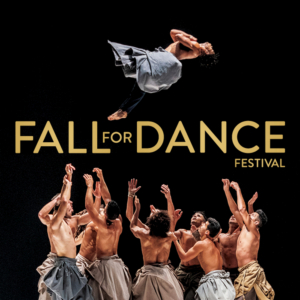Review: Dance Fail at Fall For Dance

In a city as expensive as New York, sixteen seasons of dance for $15 a ticket feels like a mitzvah, until that blessing is eroded by stale curation.
While it showcased contributions from trendy choreographers as diverse as Crystal Pite, Kyle Abraham, and Caleb Teicher, Program 1 of this year's Fall For Dance Festival reeked of middling potpourri. Why the morass, you ask? The usual suspects: a proliferation of rhythmless music.
Hubbard Street Dance Chicago opened the program with Crystal Pite's A Picture of You Falling, which continued her shtick for pairing narration alongside choreography to banal effect. Here, a man and woman bumped into each other, paused, then continued walking towards their original destination. After a few shifts in lighting, they repeated this action with a new 'what if we had gotten to know each other' tragic ending.
This 'what if' scenario was clear enough without its accompanying recitation of the obvious; instead of watching a simple collision, the audience was subjected to Kate Strong's clipped recitation of stage directions: 'You bumped into each other but kept on walking' or 'You placed your hand around her neck'. Does Pite deploy this device because she fears that the audience will fail to put five and six together? Deficiencies in storytelling aside, Hubbard Street's dancers--Jacqueline Burnett and Elliot Hammans--ably embodied Falling's slick, herky-jerky movement-quality and even managed to imprint a sense of rhythm onto Owen Belton's tuneless sounds.
Proceedings diverged for the better with the American premiere of creative director, Gregory Maqoma's Rise for Vuyani Dance Theatre. Picture a club filled with eleven sexy black men and women--some full-figured, some wiry, some ripped to the gods--all dancing the evening away to pop tunes. The onstage DJ frequently departed his rig to join the action, and though he was differently-abled--what with his crutch and missing left leg--nothing prevented him from dancing just as ferociously as his comrades in love. Women partnered men, men partnered each other, and all danced tenderly without concern for who was in charge. The message, while never clear, alternated between dancing for dancing's sake and dancing despite life's troubles. Set to everything from Drake's God's Plan to the questionable inclusion of Billy Holiday's recording of Strange Fruit, Rise developed from a cool solo that popcorned between its dancers, into expansive ensemble work built on the latest club moves, traditional South African dance techniques fused with contemporary dance, and swirling acrobatics. Following the work's enthusiastic reception, one concert goer commented, "They are like Ailey with less technique." I disagree; Vuyani's dancers are equal to Ailey's; they are simply less concerned with a finished line and more interested in their own sui generis style. Whether 'polished' according to Western standards or not, one hopes that the company will soon return to these shores.
While Vuyani's musical selections belonged largely to the recent Billboard 100 chart-list, they still focused on body-rocking rhythm. Kyle Abraham's solo for Misty Copeland plunged the evening back into the depths of tuneless scoring with a long, whining sound composed by Ryuichi Sakamoto and Alva Noto. Copeland began the piece--which was commissioned by City Center for this festival--by walking backwards towards the audience, looked over her shoulder, rose to full point, brushed her legs backwards in attitude, stood in perfectly turned-out fourth position, extended her legs to the sky, executed a series of double pencil and pique turns, skipped across the floor, then washed, rinsed and repeated these actions to diminishing effect.
Have you ever stood on a stalled train, imagining that you are slowing inching forward when in fact you are in the same exact spot that you were 5 minutes ago? Such was Ash: not even a choreographic sketch, it lost transmission before it even began to broadcast. In an interview with NYTimes, Abraham stated that he wanted to reveal a different aspect of Copeland's personality. Here he successfully reduced one of the warmest stage personas in the world to a cold, sterile automaton. At bows, Copeland thankfully returned to her vibrant and generous self.
Caleb Teicher closed the evening with his company of charming dancers. Guest beat-boxer Chris Celiz opened Bzzzz with a long pre-amble of faux-shy joking that set the tone for the long piece to come. If you found that humor amusing you probably enjoyed Teicher's recreation of trap-music rhythms to tap steps. If however you were looking for evolving invention, then the repetition probably left you wanting.
Musically faithful, well-staged, and adored by the audience; this was tap for 'the kids'. Some people exclaimed, "That was the most amazing thing I've ever seen". Teicher is indeed an incredible aficionado of diverse tap styles. In 2016, while performing on the same bill at New Victory Theater, I was pleased to witness him replicate Dr. Jimmy Slyde's style. In choreographing Bzzzz, he certainly entertained the audience and even managed to re-purpose a diverse range of tap history from vaudevillan setups to roving percussive patter... but where was the heart? Lost somewhere in the repetitive trap-music beat.
Of late, Fall For Dance has become mired in presenting cutesy tripe. From Tiler Peck's abysmal choreographic offering with Bill Irwin some years ago to this evening of reductive modernism and droning music. Undoubtedly the festival is a gift to the city, though one wonders why its programmers can't seem to strike a reasonable balance between kitschy, trendy, and substantively interesting work. L'Shana Haba'ah B'Yerushalayim.
Reader Reviews

Videos

